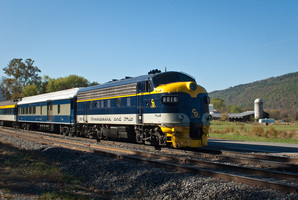 | Back to e-WV
| Back to e-WV
 The West Virginia Encyclopedia
The West Virginia Encyclopedia
 | Back to e-WV
| Back to e-WV
 The West Virginia Encyclopedia
The West Virginia Encyclopedia

The legislature created the West Virginia State Rail Authority in 1975 to assure continued freight rail service in certain areas where service was being discontinued. A seven-member board governs the Rail Authority. The state secretary of transportation, a member ex officio, serves as chairman. The governor appoints the other six members for staggered six-year terms. The main office is in Moorefield. The Rail Authority can acquire, construct, maintain, and operate rail lines and also convert abandoned rail lines into recreational trails. It must comply with requirements of the federal Regional Rail Reorganization Act of 1973.
The Chessie System turned the South Branch Valley Railroad over to the state in October 1978 for operation by the Rail Authority, making West Virginia the first state to own and operate a commercial freight railroad. The 52-mile line, which primarily serves the poultry industry, runs from Petersburg to Green Spring, where it connects with the CSX main line. A private contract operator runs the popular Potomac Eagle excursion train over the same line.
The Rail Authority has two other rail lines, as well. Private contractors operate the freight-carrying and excursion operations of the 132-mile West Virginia Central Railroad, which passes through Barbour, Randolph, Pocahontas, and Webster counties. The five-mile recreational Durbin & Greenbrier Valley Railroad is also operated privately. The Rail Authority also provides the West Virginia station facilities for the MARC (Maryland Rapid Commuter) trains which carry Eastern Panhandle workers to jobs in metropolitan Washington.
The West Virginia State Rail Authority holds seven abandoned rail lines that total 266 miles. They are used as recreational trails, including the Greenbrier River Trail, running 78 miles from North Caldwell to Cass and Durbin; the North Bend River Trail, running 72 miles from Parkersburg to Wilsonburg and Walker; and the Caperton Trail, running 50 miles from Reedsville to the Pennsylvania line. In October 2014, the State Rail Authority assumed responsibility for the operation of Pocahontas County’s historic Cass Scenic Railroad.
Written by Donald R. Andrews